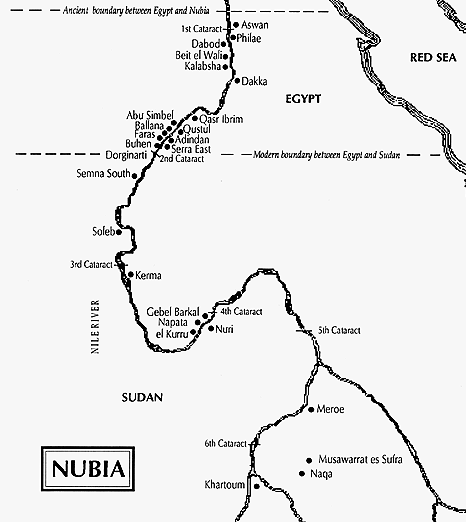
Nubia was also called - Upper & Lower Nubia, Kush, Land of Kush, Te-Nehesy, Nubadae, Napata, or the Kingdom of Meroei.
The region referred to as Lower Egypt is the northernmost portion. Upper Nubia extends south into Sudan and can be subdivided into several separate areas such as Batn El Hajar or "Belly of Rocks", the sands of the Abri-Delgo Reach, or the flat plains of the Dongola Reach. Nubia, the hottest and most arid region of the world, has caused many civilizations to be totally dependent on the Nile for existence.
Historically Nubia has been a nucleus of diverse cultures. It has been the only occupied strip of land connecting the Mediterranean world with "tropical" Africa. Thus, this put the people in close and constant contact with its neighbors for long periods of history and Nubia was an important trade route between sub-Saharan Africa and the rest of the world. Its rich material culture and tradition of languages are seen in archaeological records. The most prosperous period of Nubian civilization was that of the kingdom of Kush, which endured from about 800 BC to about 320 AD. During this time, the Nubians of Kush would at one point, assume rule over all of Nubia as well as Upper and Lower Egypt.
The regions of Nubia, Sudan and Egypt are considered by some to be the cradle of civilization. Today the term Nubian has become inclusive of Africans, African Arabs, African Americans and people of color in general.
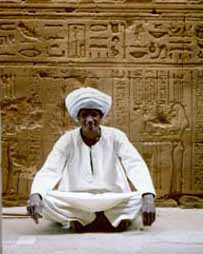
The history of the Nubians is closely linked with that of ancient Egypt.
Images of early Gods are not unlike those found on heiroglyphs of Egyptian Gods - with heads of animals and birds.
More than fifty ancient pyramids and royal tombs rise out of the desert sands at Meroe. They are Sudan's best-preserved pyramids, and one of Africa's best-kept secrets.
Unlike Egypt's famous pyramids to the north, the Pyramids of Meroe are not floodlit at night. They do not form the backdrop to a dazzling laser-light multimedia extravaganza. They do not cater to the whims of camera-toting, dollar-wielding tourists. The pyramids are a silent and awesome sight, where the intrepid traveler can soak up their ancient atmosphere in solitude.
Like the Egyptians, the Kushites believed in a life after death. This was thought to bc a continuation of life on earth. For them, the afterlife resembled this one, and they built huge graves as an enduring home for the dead. The unique social position of the pharaoh, as god on earth, was reflected in his tomb.
The king was the son of Amun-Pa the sun god and as such embodied the sun on earth. Like the sun, his life followed a cyclical plan. His youth resembled the sun rising, his maturity was like the sun at noon and his old age was comparable with the setting sun. When the king died the sun disappeared below the horizon and darkness fell.
Mythology recounted that the dying or setting sun travelled through the underworld in its journey towards the east where it was to be reborn at the dawn of the day. From time immemorial the pyramid represented the rising sun and the resurrection, and people believed that a tomb in this shape would offer the dead king the chance of rising out of death. The pyramid was seen as a ladder up to heaven enabling the dead king's soul to travel and join the gods in the heavens. At night time the king, assuming the shape of Osiris, god of the afterlife and resurrection, descended in the barque of the sun god Ra and, having become one with this god, sailed through the bouts of darkness.
Building pyramids ceased towards the end of the Middle Kingdom period. The pharaohs of the New Kingdom constructed their graves in caves with underground rooms and passages symbolizing the nightly sojourn of the sun god. The black pharaohs of the Kushite Dynasty and their descendants readopted the old pyramids for their tombs. The number of pyramids in Nubia, where a total of 223 bas been round, fat exceeds that of Egypt.
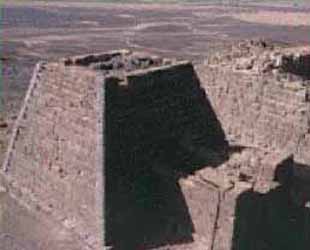
The pyramids of Nubia have three important sections. These are: 1) an underground burial place symbolizing the underworld, where the mummy lies; 2) a massive steep pyramid above, symbolizing the ladder up to heaven; 3) a small chapel on the eastern side where sacrifices could bc placed, intended to sustain the dead king on his travels. Perhaps the doors to this chapel would be opened by a priest at sunrise so that the light could shine in on the stela that was placed against the rear wall. The chapel thus also functioned as a place of prayer connected with the cult of the dead.
The underground graves of the Nubian pyramids were richly decorated. The mummified kings and queens were laid upon beds in accordance with the ancient tradition of Kerma. So that the dead monarch would not have to work in the afterlife, their tombs were filled with shabtis, small statues of people which in a magical manner would come to life when summoned by the gods to perform tasks.
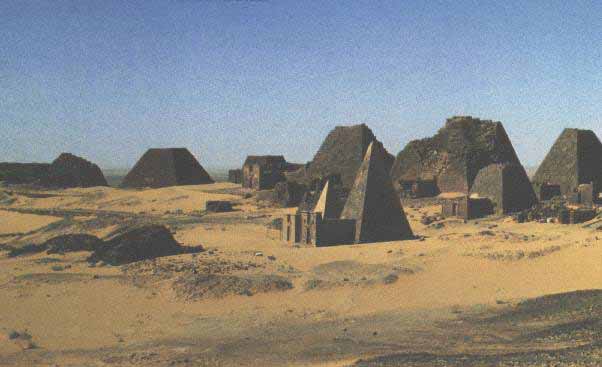
Pyramids from the Northern Cemetery at Meroe, 3rd c. B.C. to 4th c. A.D. By the 4th c. B.C., the Kushite kings had moved south to the Sudanese savannah and built a capitol at Meroe. Here southern cultural traditions slowly prevailed over the cultural heritage of Egypt.
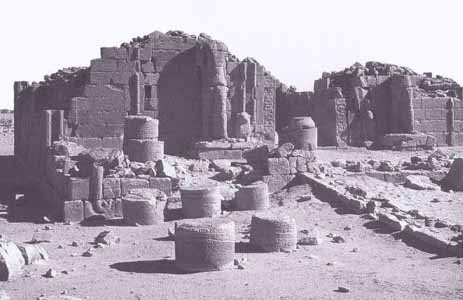
Ruins of the Merotic temple at Musawwarat es-Sufra. This temple complex, called the "Great Enclosure", lies south of Meroë near the Sixth Cataract. It may have been a pilgrammage center or a royal palace. A number of towns were located on the banks of the Atbara, Blue Nile and White Nile, in which lived craftsmen who met local needs and exported along the trade route that ran from Red Sea port towns in the East to beyond Lake Chad in the West. This route eventually connected to the major center of iron production in Jenne Jeno.
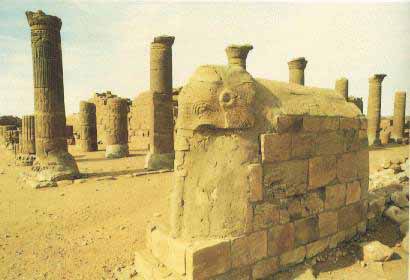
Elephant statue from the "Great Enclosure" at Musawwarat es-Sufra temple. Elephants served a military function, but the cultural influence from the South is apparently the reason for their having a religious significance, now lost to us.
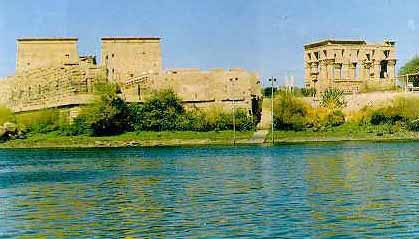
Elephantine Temples on the eastern bank of the Nile River.
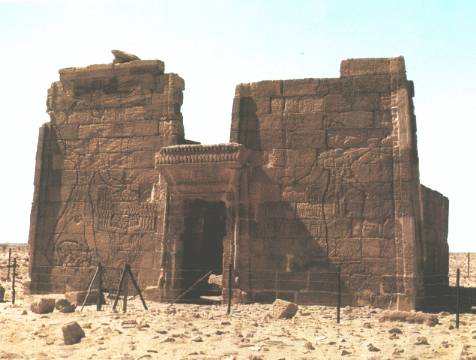
The Lion Temple of Naqa. The architectural style is Egyptian. The entrance reliefs show the king and queen striking their enemies. The queen reflects Merotic culture in both her importance being equal to that of the king, but also in her figure style.
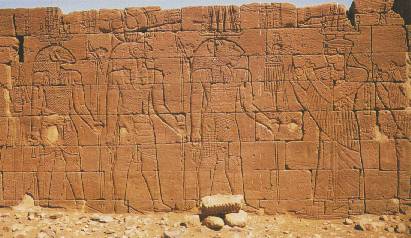
Relief from the Lion Temple at Naga, south of Meroë at the Sixth Cataract. King Natakamani stands before the lion god, Apedemek, and also Horus and Amun. The king's robe and the sash draped over his right shoulder, which is typical of Merotic dress. The Sudanese god Apedemek slowly displaced the divinities of Egypt.
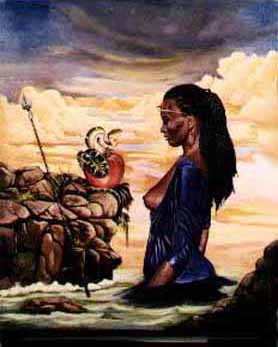
Was this the place of creation - the Garden of Eden?
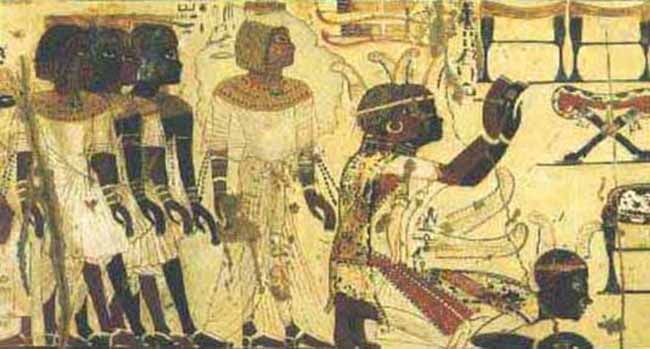
Worshipping Gods and Goddesses

Nubian Priestess - linked to creational forces - the return of the feminine energies - the tones of the dolphin the flight of the dove - transition - the flow of the collective unconscious through which all things are created
The earliest inhabitants of what is now The Sudan can be traced to African (i.e., Negroid) peoples who lived in the vicinity of Khartoum, the Sudan, in Mesolithic (Middle Stone Age) times (30,000-20,000 BC). They were hunters and gatherers who made pottery and (later) objects of ground sandstone. Toward the end of the Neolithic Period (New Stone Age; 10,000-3,000 BC) they had domesticated animals. These Africans were clearly in contact with predynastic civilizations (before c. 2925 BC) to the north in Egypt, but the arid uplands separating Egypt from Nubia appear to have discouraged the predynastic Egyptians from settling there.
At the end of the 4th millennium BC, kings of Egypt's 1st dynasty conquered upper Nubia south of Aswan, introducing Egyptian cultural influence to the African peoples who were scattered along the riverbank. In subsequent centuries, Nubia was subjected to successive military expeditions from Egypt in search of slaves or building materials for royal tombs, which destroyed much of the Egyptian-Nubian culture that had sprung from the initial conquests of the 1st dynasty.
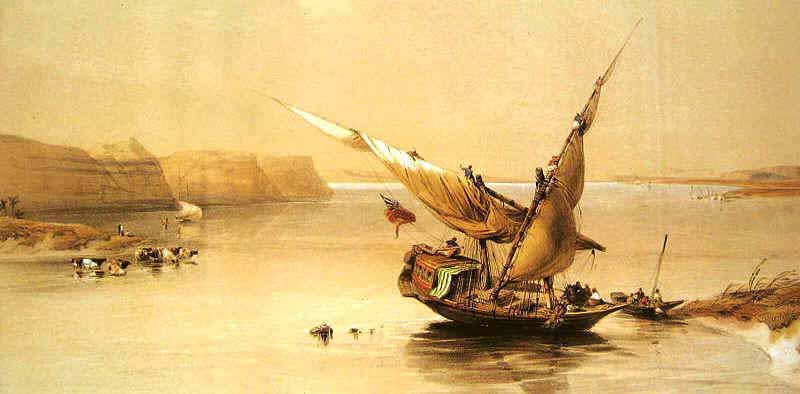
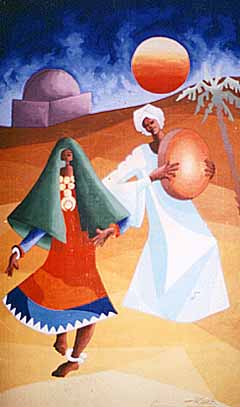
Throughout these few centuries (c. 2925-c. 2575 BC), the descendants of the Nubians continued to eke out an existence along the Nile River, an easy prey to Egyptian military expeditions. Although the Nubians were no match for the armies of Egypt's Old Kingdom, the interactions arising from their enslavement and colonization led to ever-increasing African influence upon the art, culture, and religion of dynastic Egypt.
Sometime after about 2181, in the period known to Egyptologists as the First Intermediate Period (c. 2130-1938), a new wave of immigrants entered Nubia from Libya, in the west, where the increasing desiccation of the Sahara drove them to settle along the Nile as cattle farmers. Other branches of these people seem to have gone beyond the Nile to the Red Sea Hills, while still others pushed south and west to Wadai and Darfur.
These newcomers were able to settle on the Nile and assimilate the existing Nubians without opposition from Egypt. After the fall of the 6th dynasty (c. 2150), Egypt experienced more than a century of weakness and internal strife, giving the immigrants in Nubia time to develop their own distinct civilization with unique crafts, architecture, and social structure, virtually unhindered by the potentially more dynamic civilization to the north.
With the advent of the 11th dynasty (2081), however, Egypt recovered its strength and pressed southward into Nubia, at first sending only sporadic expeditions to exact tribute, but by the 12th dynasty (1938-1756) effectively occupying Nubia as far south as Semna.
The Nubians resisted the Egyptian occupation, which was maintained only by a chain of forts erected along the Nile. Egyptian military and trading expeditions, of course, penetrated beyond Semna, and Egyptian fortified trading posts were actually established to the south at Karmah in order to protect against frequent attacks upon Egyptian trading vessels by Nubian tribesmen beyond the southern frontier.
Despite the Egyptian presence in upper Nubia, the indigenous culture of the region continued to flourish. This culture was deeply influenced by African peoples in the south and was little changed by the proximity of Egyptian garrisons or the imports of luxury articles by Egyptian traders. Indeed, the Egyptianization of Nubia appears to have actually been enhanced during the decline in Egypt's political control over Nubia in the Second Intermediate Period (c. 1630-1540 BC), when Nubians were employed in large numbers as mercenaries against the Asian Hyksos invaders of Egypt.
This experience did more to introduce Egyptian culture, which the mercenaries absorbed while fighting in Egyptian armies, than did the preceding centuries of Egyptian military occupation. Conversely, the presence of these mercenaries in Egypt contributed to the growing African influence within Egyptian culture.
The defeat of the Hyksos was the result of a national rising of the Egyptians who, once they had expelled the Hyksos from the Nile valley, turned their energies southward to reestablish the military occupation of Nubia that the Hyksos invasion had disrupted. Under Thutmose I (reigned 1493-c. 1482 BC) the Egyptian conquest of the northern Sudan was completed as far as Kurqus, 50 miles south of Abu Hamad, and subsequent Egyptian military expeditions penetrated even farther up the Nile.
This third Egyptian occupation was the most complete and the most enduring, for despite sporadic rebellions against Egyptian control Nubia was divided into two administrative units: Wawat in the north, with its provincial capital at Aswan, and Kush (also spelled Cush) in the south, with its headquarters at Napata (Marawi). Nubia as a whole was governed by a viceroy, usually a member of the royal entourage, who was responsible to the Egyptian pharaoh.
Under him were two deputies, one for Wawat and one for Kush, and a hierarchy of lesser officials. The bureaucracy was staffed chiefly by Egyptians, but Egyptianized Nubians were not uncommon. Colonies of Egyptian officials, traders, and priests surrounded the administrative centres, but beyond these outposts the Nubians continued to preserve their own distinct traditions, customs, and crafts. A syncretistic culture thus arose in Kush, fashioned by that of Egypt to the north and those of African peoples to the south.
Kush's position athwart the trade routes from Egypt to the Red Sea, and from the Nile to the south and west, brought considerable wealth from far-off places. Moreover, its cultivated areas along the Nile were rich, and in the hills the gold and emerald mines produced bullion and jewels for Egypt. The Nubians were also highly valued as soldiers.
As Egypt slipped once again into decline at the close of the New Kingdom (11th century BC), the viceroys of Kush, supported by their Nubian armies, became virtually independent kings, free of Egyptian control. By the 8th century BC, the kings of Kush came from hereditary ruling families of Egyptianized Nubian chiefs who possessed neither political nor family ties with Egypt.
Under one such king, Kashta, Kush acquired control of Upper (i.e., southern) Egypt, and under his son Piankhi (c. 750-c. 719 BC), the whole of Egypt to the shores of the Mediterranean was brought under the administration of Kush.
As a world power, however, Kush was not to last. Just when the kings of Kush had established their rule from Abu Hamad to the Nile delta, the Assyrians invaded Egypt (671 BC) and with their superior iron-forged weapons defeated the armies of Kush under the redoubtable Taharqa; by 654 the Kushites had been driven back to Nubia and the safety of their capital, Napata.
Although reduced from a great power to an isolated kingdom behind the barren hills that blocked the southward advance from Aswan, Kush continued to rule over the middle Nile for another thousand years. Its unique Egyptian-Nubian culture with its strong African accretions was preserved, while that of Egypt came under Persian, Greek, and Roman influences.
Although Egyptianized in many ways, the culture of Kush was not simply Egyptian civilization in a Nubian environment. The Kushites developed their own language, expressed first by Egyptian hieroglyphs, then their own, and finally by a cursive script. They worshiped Egyptian gods but did not abandon their own. They buried their kings in pyramids but not in the Egyptian fashion.
Their wealth continued to flow from the mines and to grow with their control of the trade routes. Soon after the retreat from Egypt the capital was moved from Napata southward to Meroe near Shandi, where the kingdom was increasingly exposed to the long-established African cultures farther south at the very time when its ties with Egypt were rapidly disappearing. The subsequent history of Kush is one of gradual decay, ending with inglorious extinction in AD 350 by the king of Aksum, who marched down from the Ethiopian highlands, destroyed Meroe, and sacked the decrepit towns along the river.
The 200 years from the fall of Kush to the middle of the 6th century is an unknown age in the Sudan. Nubia was inhabited by a people called the Nobatae by the ancient geographers and the X-Group by modern archaeologists, who are still at a loss to explain their origins.
The X-Group were clearly, however, the heirs of Kush, for their whole cultural life was dominated by Meroitic crafts and customs, and occasionally they even felt themselves sufficiently strong, in alliance with the nomadic Blemmyes (the Beja of the eastern Sudan), to attack the Romans in Upper Egypt. When this happened, the Romans retaliated, defeating the Nobatae and Blemmyes and driving them into obscurity once again.
When the Sudan was once more brought into the orbit of the Mediterranean world by the arrival of Christian missionaries in the 6th century, the middle course of the Nile was divided into three kingdoms: Nobatia, with its capital at Pachoras (modern Faras); Maqurrah, with its capital at Dunqulah (Old Dongola); and the kingdom of 'Alwah in the south, with its capital at Subah (Soba) near what is now Khartoum.
Between 543 and 575 these three kingdoms were converted to Christianity by the work of Julian, a missionary who proselytized among the Nobatia (543-545), and his successor Longinus, who between 569 and 575 consolidated the work of Julian in Nobatia and even carried Christianity to 'Alwah in the south. The new religion appears to have been adopted with considerable enthusiasm. Christian churches sprang up along the Nile, and ancient temples were refurbished to accommodate Christian worshipers.
After the retirement of Longinus, however, the Sudan once again receded into a period about which little is known, and it did not reemerge into the stream of recorded history until the coming of the Arabs in the middle of the 7th century.
After the death of the Prophet Muhammad in AD 632, the Arabs erupted from the desert steppes of Arabia and overran the lands to the east and west. Egypt was invaded in 639, and small groups of Arab raiders penetrated up the Nile and pillaged along the frontier of the kingdom of Maqurrah, which by the 7th century had absorbed the state of Nobatia. Raid and counterraid between the Arabs and the Nubians followed until a well-equipped Arab expedition under 'Abd Allah ibn Sa'd ibn Abi Sarh was sent south to punish the Nubians.
The Arabs marched as far as Dunqulah, laid siege to the town, and destroyed the Christian cathedral. They suffered heavy casualties, however, so that when the king of Maqurrah sought an armistice, 'Abd Allah ibn Sa'd agreed to peace, happy to extricate his battered forces from a precarious position.
Arab-Nubian relations were subsequently regularized by an annual exchange of gifts, by trade relations, and by the mutual understanding that no Muslims were to settle in Nubia and no Nubians were to take up residence in Egypt.
With but few interruptions this peaceful, commercial relationship lasted for nearly six centuries, its very success undoubtedly the result of the mutual advantage that both the Arabs and the Nubians derived from it. The Arabs had a stable frontier; they appear to have had no designs to occupy the Sudan and were probably discouraged from doing so by the arid plains south of Aswan.
Peace on the frontier was their object, and this the treaty guaranteed. In return, the kingdom of Maqurrah gained another 600 years of life.
When non-Arab Muslims acquired control of the Nile delta, friction arose in Upper Egypt. In the 9th century the Turkish Tulunid rulers of Egypt, wishing to rid themselves of the unruly nomadic Arab tribes in their domain, encouraged them to migrate southward. Lured by the prospects of gold in the Nubian Desert, the nomads pressed into Nubia, raiding and pillaging along borders, but the heartland of Maqurrah remained free from direct hostilities until the Mamluks established their control over Egypt (1250).
In the late 13th and early 14th centuries, the Mamluk sultans sent regular military expeditions against Maqurrah, as much to rid Egypt of uncontrollable Arab Bedouins as to capture Nubia. The Mamluks never succeeded in actually occupying Maqurrah, but they devastated the country, draining its political and economic vitality and plunging it into chaos and depression.
By the 15th century Dunqulah was no longer strong enough to withstand Arab encroachment, and the country was open to Arab immigration. Once the Arab nomads, particularly the Juhaynah people, learned that the land beyond the Aswan reach could support their herds and that no political authority had the power to turn them back, they began to migrate southward, intermarrying with the Nubians and introducing Arabic Muslim culture to the Christian inhabitants.
The Arabs, who inherited through the male line, soon acquired control from the Nubians, who inherited through the female line, intermarriage resulting in Nubian inheritances passing from Nubian women to their half-Arab sons, but the Arabs replaced political authority in Maqurrah only with their own nomadic institutions.
From Dunqulah the Juhaynah and others wandered east and west of the Nile with their herds; in the south the kingdom of 'Alwah stood as the last indigenous Christian barrier to Arab occupation of the Sudan.
'Alwah extended from Kabushiyah as far south as Sennar (Sannar). Beyond, from the Ethiopian escarpment to the White Nile, lived peoples about which little is known. 'Alwah appears to have been much more prosperous and stronger than Maqurrah. It preserved the ironworking techniques of Kush, and its capital at Subah possessed many impressive buildings, churches, and gardens.
Christianity remained the state religion, but 'Alwah's long isolation from the Christian world had probably resulted in bizarre and syncretistic accretions to liturgy and ritual. 'Alwah was able to maintain its integrity so long as the Arabs failed to combine against it, but the continuous and corrosive raids of the Bedouins throughout the 15th century clearly weakened its power to resist. Thus, when an Arab confederation led by 'Abd Allah Jamma' was at last brought together to assault the Christian kingdom, 'Alwah collapsed (c. 1500). Subah and the Blue Nile region were abandoned, left to the Funj, who suddenly appeared, seemingly from nowhere, to establish their authority from Sennar to the main Nile.
The Funj were a strange and mysterious people. They were neither Arabs nor Muslims, and their homeland was probably on the upper Blue Nile in the borderlands between Ethiopia and the Sudan. Under their leader, 'Amarah Dunqas, the Funj founded their capital at Sennar and throughout the 16th century struggled for control of the Al-Jazirah (Gezira) region against the Arab tribes who had settled around the confluence of the Blue and the White Niles. The Funj appear to have firmly established their supremacy by 1607-08.
By the mid-17th century the Funj dynasty had reached its golden age under one of its greatest kings, Badi II Abu Daqn (reigned 1644/45-80), who extended Funj authority across the White Nile into Kordofan and reduced the tribal chieftaincies scattered northward along the main Nile to tribute-paying feudatories. But as Badi expanded Funj power, he also planted the seeds of its decline. During his conquests, slaves were captured and taken to Sennar, where, as they grew in numbers and influence, they formed a military caste.
Loyal to the monarch alone, the slaves soon came to compete with the Funj aristocracy for control of the offices of state. Intrigue and hostility between these two rival groups soon led to open rebellion that undermined the position of the traditional ruling class.
Under Badi IV Abu Shulukh (reigned 1724-62), the ruling aristocracy was finally broken, and the king assumed arbitrary power, supported by his slave troops. So long as Badi IV could command the loyalty of his army, his position was secure and the kingdom enjoyed respite from internal strife, but at the end of his long reign he could no longer control the army. Under the leadership of his viceroy in Kordofan, Abu Likaylik, the military turned against the king and exiled him to Subah.
Abu Likaylik probably represented a resurgence of older indigenous elements who had been Arabized and Islamized but were neither Arab nor Funj.
Thenceforward, the Funj kings were but puppets of their viziers (chief ministers), whose struggles to win and to keep control precipitated the kingdom into steady decline, interrupted by only infrequent periods of peace and stability established by a strong vizier who was able to overcome his rivals.
During its last half century the Funj kingdom was a spent state, kept intact only through want of a rival, but gradually disintegrating through wars, intrigue, and conspiracy, until the Egyptians advanced on Sennar in 1821 and pushed the Funj empire into oblivion.
The Funj were originally non-Muslims, but the aristocracy soon adopted Islam and, although they retained many traditional African customs, remained nominal Muslims. The conversion was largely the work of a handful of Islamic missionaries who came to the Sudan from the larger Muslim world. The great success of these missionaries, however, was not among the Funj themselves but among the Arabized Nubian population settled along the Nile.
Among these villagers the missionaries instilled a deep devotion to Islam that appears to have been conspicuously absent among the nomadic Arabs who first reached the Sudan after the collapse of the kingdom of Maqurrah. One early missionary was Ghulam Allah ibn 'A'id from the Yemen, who settled at Dunqulah in the 14th century. He was followed in the 15th century by Hamad Abu Danana, who appears to have emphasized the way to God through mystical exercises rather than through the more orthodox interpretations of the Qur'an taught by Ghulam Allah.
The spread of Islam was advanced in the 16th century, when the hegemony of the Funj enhanced security. In the 16th and 17th centuries, numerous schools of religious learning were founded along the White Nile, and the Shayqiyah confederacy was converted. Many of the more famous Sudanese missionaries who followed them were Sufi holy men, members of influential religious brotherhoods who sought the way to God through mystical contemplation.
The Sufi brotherhoods themselves played a vital role in linking the Sudan to the larger world of Islam beyond the Nile valley. Although the fervour of Sudanese Islam waned after 1700, the great reform movements that shook the Muslim world in the late 18th and early 19th centuries produced a revivalist spirit among the Sufi brotherhoods, giving rise to a new order, the Mirghaniyah or Khatmiyah, later one of the strongest in the modern Sudan.
These men, called faqihs, attracted a following by their teachings and piety and laid the foundations for a long line of indigenous Sudanese holy men. The latter passed on the way to God taught them by their masters, or founded their own religious schools, or, if extraordinarily successful, gathered their own following into a religious order. The faqihs played a vital role in educating their followers and helped place them in the highest positions of government, by which they were able to spread Islam and the influence of their respective brotherhoods.
The faqihs held a religious monopoly until the introduction, under Egyptian-Ottoman rule (see below), of an official hierarchy of jurists and scholars, the 'ulama', whose orthodox legalistic conception of Islam was as alien to the Sudanese as were their origins.
This disparity between the mystical, traditional faqihs, close to the Sudanese, if not of them, and the orthodox, Islamic jurists, aloof, if not actually part of the government bureaucracy, created a rivalry that in the past produced open hostility in times of trouble and sullen suspicion in times of peace. Recently, this schism has diminished; the faqih continues his customary practices unmolested, while the Sudanese have acknowledged the position of the 'ulama' in society.
Muhammad 'Ali and his successors
In July 1820, Muhammad 'Ali, viceroy of Egypt under the Ottoman Turks, sent an army under his son Isma'il to conquer the Sudan. Muhammad 'Ali was interested in the gold and slaves that the Sudan could provide and wished to control the vast hinterland south of Egypt. By 1821 the Funj and the sultan of Darfur had surrendered to his forces, and the Nilotic Sudan from Nubia to the Ethiopian foothills and from the 'Atbarah River to Darfur became part of his expanding empire.
The collection of taxes under Muhammad 'Ali's regime amounted to virtual confiscation of gold, livestock, and slaves, and opposition to his rule became intense, eventually erupting into rebellion and the murder of Isma'il and his bodyguard. But the rebels lacked leadership and coordination, and their revolt was brutally suppressed. A sullen hostility in the Sudanese was met by continued repression until the appointment of 'Ali Khurshid Agha as governor-general in 1826.
His administration marked a new era in Egyptian-Sudanese relations. He reduced taxes and consulted the Sudanese through the respected Sudanese leader 'Abd al-Qadir wad az-Zayn. Letters of amnesty were granted to fugitives. A more equitable system of taxation was implemented, and the support of the powerful class of holy men and sheikhs (tribal chiefs) for the administration was obtained by exempting them from taxation.
But 'Ali Khurshid was not content merely to restore the Sudan to its previous condition. Under his initiative trade routes were protected and expanded, Khartoum was developed as the administrative capital, and a host of agricultural and technical improvements were undertaken. When he retired to Cairo in 1838, Khurshid left a prosperous and contented country behind him.
His successor, Ahmad Pasha Abu Widan, with but few exceptions, continued his policies and made it his primary concern to root out official corruption. Abu Widan dealt ruthlessly with offenders or those who sought to thwart his schemes to reorganize taxation. He was particularly fond of the army, which reaped the benefits of regular pay and tolerable conditions in return for the brunt of the expansion and consolidation of Egyptian administration in Kassala and among the Baqqarah Arabs of southern Kordofan. Muhammad 'Ali, suspecting Abu Widan of disloyalty, recalled him to Cairo in the autumn of 1843, but he died mysteriously, many believed of poison, before he left the Sudan.
During the next two decades the country stagnated because of ineffective government at Khartoum and vacillation by the viceroys at Cairo. If the successors of Abu Widan possessed administrative talent, they were seldom able to demonstrate it. No governor-general held office long enough to introduce his own plans, let alone carry on those of his predecessor.
New schemes were never begun, and old projects were allowed to languish. Without direction the army and the bureaucracy became demoralized and indifferent, while the Sudanese became disgruntled with the government. In 1856 the viceroy Sa'id Pasha visited the Sudan and, shocked by what he saw, contemplated abandoning it altogether. Instead, he abolished the office of governor-general and had each Sudanese province report directly to the viceregal authority in Cairo. This state of affairs persisted until the more dynamic viceroy Isma'il took over the guidance of Egyptian and Sudanese affairs in 1862.
During these quiescent decades, however, two ominous developments began that presaged future problems. Reacting to pressure from the Western powers, particularly Great Britain, the governor-general of the Sudan was ordered to halt the slave trade. But not even the viceroy himself could overcome established custom with the stroke of a pen and the erection of a few police posts.
If the restriction of the slave trade precipitated resistance among the Sudanese, the appointment of Christian officials to the administration and the expansion of the European Christian community in the Sudan caused open resentment. European merchants, mostly of Mediterranean origin, were either ignored or tolerated by the Sudanese and confined their contacts to compatriots within their own community and to the Turko-Egyptian officials whose manners and dress they frequently adopted. They became a powerful and influential group, whose lasting contribution to the Sudan was to take the lead in opening the White Nile and the southern Sudan to navigation and commerce after Muhammad 'Ali had abolished state trading monopolies in the Sudan in 1838 under pressure from the European powers.
In 1863, Isma'il Pasha became viceroy of Egypt. Educated in Egypt, Vienna, and Paris, Isma'il had absorbed the European interest in overseas adventures as well as Muhammad 'Ali's desire for imperial expansion and had imaginative schemes for transforming Egypt and the Sudan into a modern state by employing Western technology.
First he hoped to acquire the rest of the Nile basin, including the southern Sudan and the Bantu states by the great lakes of central Africa. To finance this vast undertaking, and his projects for the modernization of Egypt itself, Isma'il turned to the capital-rich nations of western Europe, where investors were willing to risk their savings at high rates of interest in the cause of Egyptian and African development.
But such funds would be attracted only as long as Isma'il demonstrated his interest in reform by intensifying the campaign against the slave trade in the Sudan. Isma'il needed no encouragement, for he required the diplomatic and financial support of the European powers in his efforts to modernize Egypt and expand his empire. Thus, these two major themes of Isma'il's rule of the Nilotic Sudan--imperial expansion and the suppression of the slave trade--became intertwined, culminating in a third major development, the introduction of an ever-increasing number of European Christians to carry out the task of modernization.
In 1869 Isma'il commissioned the Englishman Samuel Baker to lead an expedition up the White Nile to establish Egyptian hegemony over the equatorial regions of central Africa and to curtail the slave trade on the upper Nile. Baker remained in equatorial Africa until 1873, where he established the Equatoria province as part of the Egyptian Sudan. He had extended Egyptian power and curbed the slave traders on the Nile, but he had also alienated certain African tribes and, being a rather tactless Christian, Isma'il's Muslim administrators as well. Moreover, Baker had struck only at the Nilotic slave trade.
To the west, on the vast plains of the Bahr Al-Ghazal (now a state of the Republic of The Sudan), slave merchants had established enormous empires with stations garrisoned by slave soldiers.
From these stations the long lines of human chattels were sent overland through Darfur and Kordofan to the slave markets of the northern Sudan, Egypt, and Arabia. Not only did the firearms of the Khartoumers (as the traders were called) establish their supremacy over the peoples of the interior but also those merchants with the strongest resources gradually swallowed up lesser traders until virtually the whole of the Bahr Al-Ghazal was controlled by the greatest slaver of them all, az-Zubayr Rahma Mansur, more commonly known as Zubayr (or Zobeir) Pasha.
So powerful had he become that in 1873, the year Baker retired from the Sudan, the Egyptian viceroy (now called the khedive) appointed Zubayr governor of the Bahr Al-Ghazal. Isma'il's officials had failed to destroy Zubayr as Baker had crushed the slavers east of the Nile, and to elevate Zubayr to the governorship appeared the only way to establish at least the nominal sovereignty of Cairo over that enormous province. Thus, the agents of Zubayr continued to pillage the Bahr Al-Ghazal under the Egyptian flag, while officially Egypt extended its dominion to the tropical rainforests of the Congo region. Zubayr remained in detention in Cairo.
Isma'il next offered the governorship of the Equatoria province to another Englishman, Charles George Gordon, who in China had won fame and the sobriquet Chinese Gordon. Gordon arrived in Equatoria in 1874. His object was the same as Baker's--to consolidate Egyptian authority in Equatoria and to establish Egyptian sovereignty over the kingdoms of the great East African lakes. He achieved some success in the former and none in the latter. When Gordon retired from Equatoria, the lake kingdoms remained stubbornly independent.
In 1877 Isma'il appointed Gordon governor-general of the Sudan. Gordon was a European and a Christian. He returned to the Sudan to lead a crusade against the slave trade, and, to assist him in this humanitarian enterprise, he surrounded himself with a cadre of European and American Christian officials. In 1877 Isma'il had signed the Anglo-Egyptian Slave Trade Convention, which provided for the termination of the sale and purchase of slaves in the Sudan by 1880. Gordon set out to fulfill the terms of this treaty, and in whirlwind tours through the country he broke up the markets and imprisoned the traders. His European subordinates did the same in the provinces.
Gordon's crusading zeal blinded him to his invidious position as a Christian in a Muslim land and obscured from him the social and economic effects of arbitrary repression. Not only did his campaign create a crisis in the Sudan's economy but the Sudanese soon came to believe that the crusade, led by European Christians, violated the principles and traditions of Islam.
By 1879 a strong current of reaction against Gordon's reforms was running through the country. The powerful slave-trading interests had, of course, turned against the administration, while the ordinary villagers and nomads, who habitually blamed the government for any difficulties, were quick to associate economic depression with Gordon's Christianity. And then suddenly, in the middle of rising discontent in the Sudan, Isma'il's financial position collapsed. In difficulties for years, he could now no longer pay the interest on the Egyptian debt, and an international commission was appointed by the European powers to oversee Egyptian finances. After 16 years of glorious spending, Isma'il sailed away into exile. Gordon resigned.
Gordon left a perilous situation in the Sudan. The Sudanese were confused and dissatisfied. Many of the ablest senior officials, both European and Egyptian, had been dismissed by Gordon, departed with him, or died in his service. Castigated and ignored by Gordon, the bureaucracy had lapsed into apathy. Moreover, the office of governor-general, on which the administration was so dependent, devolved upon Muhammad Ra'uf Pasha, a mild man, ill-suited to stem the current of discontent or to shore up the structure of Egyptian rule, particularly when he could no longer count on Egyptian resources. Such then was the Sudan in June of 1881 when Muhammad Ahmad declared himself to be the Mahdi ("the divinely guided one").
Muhammad Ahmad ibn 'Abd Allah was the son of a Dunqulahwi boatbuilder who claimed descent from the Prophet Muhammad. Deeply religious from his youth, he was educated in one of the Sufi orders, the Sammaniyah, but he later secluded himself on Aba Island in the White Nile to practice religious asceticism.
In 1880 he toured Kordofan, where he learned of the discontent of the people and observed those actions of the government that he could not reconcile with his own religious beliefs. Upon his return to Aba Island he clearly viewed himself as a mujaddid, a renewer of the Muslim faith, his mission to reform Islam and return it to the pristine form practiced by the Prophet.
To Muhammad Ahmad the orthodox 'ulama' who supported the administration were no less infidels than Christians, and, when he later lashed out against misgovernment, he was referring as much to the theological heresy as to secular maladministration.
Once he had proclaimed himself Mahdi (a title traditionally used by Islamic religious reformers), Muhammad Ahmad was regarded by the Sudanese as an eschatological figure, one who foreshadows the end of an age of darkness (which happened to coincide with the end of the 13th Muslim century) and heralds the beginnings of a new era of light and righteousness. Thus, as a divinely guided reformer and symbol, Muhammad Ahmad fulfilled the requirements of Mahdi in the eyes of his supporters.
Surrounding the Mahdi were his followers, the ansar, and foremost among them was 'Abd Allah ibn Muhammad, the caliph (khalifah; "deputy"), who came from the Ta'a'ishah tribe of the Baqqarah Arabs and who assumed the leadership of the Mahdist state upon the death of Muhammad Ahmad.
The holy men, the faqihs, who for long had lamented the sorry state of religion in the Sudan brought on by the legalistic and unappealing orthodoxy of the Egyptians, looked to the Mahdi to purge the Sudan of the faithless ones. Also in his following, more numerous and powerful than the holy men, were the merchants formerly connected with the slave trade. All had suffered from Gordon's campaign against the trade, and all now hoped to reassert their economic position under the banner of religious war. Neither of these groups, however, could have carried out a revolution by themselves.
The third and vital participants were the Baqqarah Arabs, the cattle nomads of Kordofan and Darfur who hated taxes and despised government. They formed the shock troops of the Mahdist revolutionary army, whose enthusiasm and numbers made up for its primitive technology. Moreover, the government itself only managed to enhance the prestige of the Mahdi by its fumbling attempts to arrest him and proscribe his movement.
By September 1882, the Mahdists controlled all of Kordofan and at Shaykan on Nov. 5, 1883, destroyed an Egyptian army of 10,000 men under the command of a British colonel. After Shaykan, the Sudan was lost, and not even the heroic leadership of Gordon, who was hastily sent to Khartoum, could save the Sudan for Egypt. On Jan. 26, 1885, the Mahdists captured Khartoum and massacred Gordon and the defenders.
Five months after the fall of Khartoum, the Mahdi suddenly died on June 22, 1885. He was succeeded by the Khalifah 'Abd Allah. The Khalifah's first task was to secure his own precarious position among the competing factions in the Mahdist state. He frustrated a conspiracy by the Mahdi's relatives and disarmed the personal retinues of his leading rivals in Omdurman, the Mahdist capital of the Sudan. Having curtailed the threats to his rule, the Khalifah sought to accomplish the Mahdi's dream of a universal jihad (holy war) to reform Islam throughout the Muslim world.
With a zeal compounded from a genuine wish to carry out religious reform, a desire for military victory and personal power, and an appalling ignorance of the world beyond the Sudan, the forces of the Khalifah marched to the four points of the compass to spread Mahdism and extend the domains of the Mahdist state. By 1889 this expansionist drive was spent. In the west the Mahdist armies had achieved only an unstable occupation of Darfur.
In the east they had defeated the Ethiopians, but the victory produced no permanent gain. In the southern Sudan the Mahdists had scored some initial successes but were driven from the upper Nile in 1897 by the forces of the Congo Free State of Leopold II of Belgium.
On the Egyptian frontier in the north the jihad met its worst defeat at Tushki in August 1889, when an Anglo-Egyptian army under General F.W. (later Baron) Grenfell destroyed a Mahdist army led by 'Abd ar-Rahman an-Nujumi.
The Mahdist state had squandered its resources on the jihad, and a period of consolidation and contraction followed, necessitated by a sequence of bad harvests resulting in famine, epidemic, and death.
Between 1889 and 1892 the Sudan suffered its most devastating and terrible years, as the Sudanese sought to survive on their shriveled crops and emaciated herds. After 1892 the harvests improved, and food was no longer in short supply.
Moreover, the autocracy of the Khalifah had become increasingly acceptable to most Sudanese, and, having tempered his own despotism and eliminated the gross defects of his administration he too received the widespread acceptance, if not devotion, that the Sudanese had accorded the Mahdi.
In spite of its many defects, the Khalifah's administration served the Sudan better than its many detractors would admit. Certainly the Khalifah's government was autocratic, but, while autocracy may be repugnant to European democrats, it was not only understandable to the Sudanese but appealed to their deepest feelings and attitudes formed by tribe, religion, and past experience with the centralized authoritarianism of the Turks. For them, the Khalifah was equal to the task of governing bequeathed him by the Mahdi.
Only when confronted by new forces from the outside world, of which he was ignorant, did 'Abd Allah's abilities fail him. His belief in Mahdism, his reliance on the superb courage and military skill of the ansar, and his own ability to rally them against an alien invader were simply insufficient to preserve his independent Islamic state against the overwhelming technological superiority of Britain. And, as the 19th century drew to a close, the rival imperialisms of the European powers brought the full force of this technological supremacy against the Mahdist state.
British forces invaded and occupied Egypt in 1882 to put down a nationalist revolution hostile to foreign interests and remained there to prevent any further threat to the khedive's government or the possible intervention of another European power. The consequences of this were far-reaching. A permanent British occupation of Egypt required the inviolability of the Nile waters without which Egypt could not survive, not from any African state, who did not possess the technical resources to interfere with them, but from rival European powers, who could. Consequently, the British government, by diplomacy and military maneuvers, negotiated agreements with the Italians and the Germans to keep them out of the Nile valley.
They were less successful with the French, who wanted them to withdraw from Egypt. Once it became apparent that the British were determined to remain, the French cast about for means to force the British from the Nile valley; in 1893 an elaborate plan was concocted by which a French expedition would march across Africa from the west coast to Fashoda (Kodok) on the upper Nile, where it was believed a dam could be constructed to obstruct the flow of the Nile waters. After inordinate delays, the French Nile expedition set out for Africa in June 1896, under the command of Captain Jean-Baptiste Marchand.
As reports reached London during 1896 and 1897 of Marchand's march to Fashoda, Britain's inability to insulate the Nile valley became embarrassingly exposed. British officials desperately tried one scheme after another to beat the French to Fashoda.
They all failed, and by the autumn of 1897 British authorities had come to the reluctant conclusion that the conquest of the Sudan was necessary to protect the Nile waters from French encroachment. In October an Anglo-Egyptian army under the command of General Sir Horatio Herbert Kitchener was ordered to invade the Sudan.
Kitchener pushed steadily but cautiously up the Nile. His Anglo-Egyptian forces defeated a large Mahdist army at the 'Atbarah River on April 8, 1898. Then, after spending four months preparing for the final advance to Omdurman, Kitchener's army of about 25,000 troops met the massed 60,000-man army of the Khalifah outside the city on Sept. 2, 1898. By midday the Battle of Omdurman was over.
The Mahdists were decisively defeated with heavy losses, and the Khalifah fled, to be killed nearly a year later. Kitchener did not long remain at Omdurman but pressed up the Nile to Fashoda with a small flotilla. There on Sept. 18, 1898, he met Captain Marchand, who declined to withdraw--the long-expected Fashoda crisis had begun. Both the French and British governments prepared for war. Neither the French army nor the navy was in any condition to fight, however, and the French were forced to give way. An Anglo-French agreement of March 1899 stipulated that French expansion eastward in Africa would stop at the Nile watershed.
The early years of British rule
Having conquered the Sudan, the British now had to govern it. But the administration of this vast land was complicated by the legal and diplomatic problems that had accompanied the conquest. The Sudan campaigns had been undertaken by the British to protect their imperial position as well as the Nile waters, yet the Egyptian treasury had borne the greater part of the expense, and Egyptian troops had far outnumbered those of Britain in the Anglo-Egyptian army.
The British, however, did not simply want to hand the Sudan over to Egyptian rule; most Englishmen were convinced that the Mahdiyah was the result of 60 years of Egyptian oppression.
To resolve this dilemma the Anglo-Egyptian Condominium was declared in 1899, whereby the Sudan was given separate political status in which sovereignty was jointly shared by the khedive and the British crown, and the Egyptian and the British flags were flown side by side. The military and civil government of the Sudan was invested in a governor-general appointed by the khedive of Egypt but nominated by the British government. In reality, there was no equal partnership between Britain and Egypt in the Sudan.
From the first the British dominated the condominium and set about pacifying the countryside and suppressing local religious uprisings, which created insecurity among British officials but never posed a major threat to their rule. The north was quickly pacified and modern improvements were introduced under the aegis of civilian administrators, who began to replace the military as early as 1900. In the south, resistance to British rule was more prolonged; administration there was confined to keeping the peace rather than making any serious attempts at modernization.
The first governor-general was Lord Kitchener himself, but in 1899 his former aide, Sir Reginald Wingate, was appointed to succeed him. Wingate knew the Sudan well and during his long tenure as governor-general (1899-1916) became devoted to its people and their prosperity. His tolerance and trust in the Sudanese resulted in policies that did much to establish confidence in Christian British rule by a devoutly Muslim, Arab-oriented people.
Modernization was slow at first. Taxes were purposely kept light, and the government consequently had few funds available for development. In fact, the Sudan remained dependent on Egyptian subsidies for many years. Nevertheless, railways, telegraph, and steamer services were expanded, particularly in Al-Jazirah, in order to launch the great cotton-growing scheme that remains today the backbone of The Sudan's economy. In addition, technical and primary schools were established, including the Gordon Memorial College, which opened in 1902 and soon began to graduate a Western-educated elite that was gradually drawn away from the traditional political and social framework. Scorned by the British officials, who preferred the illiterate but contented fathers to the ill-educated, rebellious sons, and adrift from their own customary tribal and religious affiliations, these Sudanese turned for encouragement to Egyptian nationalists; from that association Sudanese nationalism in this century was born.
Its first manifestations occurred in 1921, when 'Ali 'Abd al-Latif founded the United Tribes Society and was arrested for nationalist agitation. In 1924 he formed the White Flag League, dedicated to driving the British from the Sudan. Demonstrations followed in Khartoum in June and August and were suppressed. When the governor-general, Sir Lee Stack, was assassinated in Cairo on Nov. 19, 1924, the British forced the Egyptians to withdraw from the Sudan and annihilated a Sudanese battalion that mutinied in support of the Egyptians. The Sudanese revolt was ended, and British rule remained unchallenged until after World War II.
n 1936 Britain and Egypt had reached a partial accord in the Anglo-Egyptian Treaty that enabled Egyptian officials to return to the Sudan. Although the traditional Sudanese sheikhs and chiefs remained indifferent to the fact that they had not been consulted in the negotiations over this treaty, the educated Sudanese elite were resentful that neither Britain nor Egypt had bothered to solicit their opinions. Thus, they began to express their grievances through the Graduates' General Congress, which had been established as an alumni association of Gordon Memorial College and soon embraced all educated Sudanese.
At first, the Graduates' General Congress confined its interests to social and educational activities, but with Egyptian support the organization demanded recognition by the British to act as the spokesman for Sudanese nationalism. The Sudan government refused, and the Congress split into two groups: a moderate majority prepared to accept the good faith of the government, and a radical minority, led by Isma'il al-Azhari, which turned to Egypt. By 1943 Azhari and his supporters had won control of the Congress and organized the Ashiqqa' (Brothers), the first genuine political party in the Sudan. Seeing the initiative pass to the militants, the moderates formed the Ummah (Nation) Party under the patronage of Sayyid 'Abd ar-Rahman al-Mahdi, the posthumous son of the Mahdi, with the intention of cooperating with the British toward independence.
Sayyid 'Abd ar-Rahman had inherited the allegiance of the thousands of Sudanese who had followed his father. He now sought to combine to his own advantage this power and influence with the ideology of the Ummah. His principal rival was Sayyid 'Ali al-Mirghani, the leader of the Khatmiyah brotherhood. Although he personally remained aloof from politics, Sayyid 'Ali threw his support to Azhari. The competition between the Azhari-Khatmiyah faction--remodeled in 1951 as the National Unionist Party (NUP)--and the Ummah-Mahdist group quickly rekindled old suspicions and deep-seated hatreds that soured Sudanese politics for years and eventually strangled parliamentary government. These sectarian religious elites virtually controlled The Sudan's political parties until the last decade of the 20th century, stultifying any attempt to democratize the country or to include the millions of Sudanese remote from Khartoum in the political process.
Although the Sudanese government had crushed the initial hopes of the congress, the British officials were well aware of the pervasive power of nationalism among the elite and sought to introduce new institutions to associate the Sudanese more closely with the task of governing. An Advisory Council was established for the northern Sudan consisting of the governor-general and 28 Sudanese, but Sudanese nationalists soon began to agitate to transform the Advisory Council into a legislative one that would include the southern Sudan. The British had facilitated their control of the Sudan by segregating the animist or Christian Africans who predominated in the south from the Muslim Arabs who were predominant in the north. The decision to establish a legislative council forced the British to abandon this policy; in 1947 they instituted southern participation in the legislative council.
The creation of this council produced a strong reaction on the part of the Egyptian government, which in October 1951 unilaterally abrogated the Anglo-Egyptian Treaty of 1936 and proclaimed Egyptian rule over the Sudan. These hasty and ill-considered actions only managed to alienate the Sudanese from Egypt until the Nasser-Naguib revolution in July 1952 placed men with more understanding of Sudanese aspirations in power in Cairo.
On Feb. 12, 1953, the Egyptian government signed an agreement with Britain granting self-government for the Sudan and self-determination within three years for the Sudanese. Elections for a representative Parliament to rule the Sudan followed in November and December 1953. The Egyptians threw their support behind Isma'il al-Azhari, the leader of the National Unionist Party, who campaigned on the slogan "Unity of the Nile Valley." This position was opposed by the Ummah Party, which had the less vocal but pervasive support of British officials. To the shock of many British officials and to the chagrin of the Ummah, which had enjoyed power in the Legislative Council for nearly six years, Azhari's NUP won an overwhelming victory. Although Azhari had campaigned to unite the Sudan with Egypt, the realities of disturbances in the southern Sudan and the responsibilities of political power and authority ultimately led him to disown his own campaign promises and to declare The Sudan an independent republic with an elected representative Parliament on Jan. 1, 1956.
The triumph of liberal democracy in The Sudan was short-lived. Compared with the strength of tradition, which still shaped the life of the Sudanese, the liberalism imported from the West, disseminated through British education and adopted by the Sudanese intelligentsia, was a weak force. At first parliamentary government had been held in high esteem as the symbol of nationalism and independence. But at best Parliament was a superficial instrument. It had been introduced into The Sudan at precisely the time parliamentary forms were rapidly disappearing from other countries in the Middle East. Political parties were not well-organized groups with distinct objectives, but loose alliances motivated primarily by personal interests and loyalty to the various religious factions. When the tactics of party management were exhausted, Parliament became debased, benefiting only those politicians who reaped the rewards of power and patronage. Disillusioned with their experiment in liberal democracy, the Sudanese turned once again to authoritarianism.
On the night of Nov. 16-17, 1958, the commander in chief of the Sudanese army, General Ibrahim Abbud, carried out a bloodless coup d'état, dissolving all political parties, prohibiting assemblies, and temporarily suspending newspapers. A Supreme Council of the Armed Forces, consisting of 12 senior officers, was set up, and army rule brought rapid economic improvements. The Abbud government at once abolished the fixed price on cotton and sold all the Sudanese cotton, rebuilding the nation's foreign reserves.
On Nov. 8, 1959, the government concluded an agreement with Egypt on the Nile waters, by which Egypt not only recognized but also appeared to be reconciled to an independent Sudan. In the southern Sudan, Abbud's policies were less successful. In the name of national unity the army officers introduced many measures designed to facilitate the spread of Islam and the Arabic language. Important positions in the administration and police were staffed by northern Sudanese. Education was shifted from the English curriculum of the Christian missionaries, who had long been solely responsible for education in the south, to an Arabic, Islamic orientation. Foreign Christian missionaries were expelled between 1962 and 1964.
In the southern Sudan itself, the measures of the central government met ever-increasing resistance. In October 1962 a widespread strike in southern schools resulted in antigovernment demonstrations followed by a general flight of students and others over the border. In September 1963 rebellion erupted in eastern Al-Istiwa'iyah (Equatoria) and in the A'ali An-Nil (Upper Nile) province led by the Anya Nya, a southern Sudanese guerrilla organization that believed that only violent resistance would make the government of General Abbud seek a solution acceptable to the southerners. In return the generals in Khartoum increased repression.
Although the northern Sudanese had little sympathy for their countrymen in the south, the intelligentsia was able to use the government's failure there to assail authoritarian rule in the north and to revive demands for democratic government. By 1962, numerous urban elements, including the intelligentsia, the trade unions, and the civil service, as well as the powerful religious brotherhoods, had become alienated from the military regime. Moreover, the tribal masses and growing proletariat had become increasingly apathetic toward the government. In the end the regime was overwhelmed by boredom and overthrown by the reaction to its lassitude. The means of its overthrow was the southern problem.
In October 1964, students at the University of Khartoum held a meeting, in defiance of a government prohibition, in order to condemn government action in the southern Sudan and to denounce the regime. Demonstrations followed, and, with most of its forces committed in the southern Sudan, the military regime was unable to maintain control. The disorders soon spread, and General Abbud resigned as head of state; a transitional government was appointed to serve under the provisional constitution of 1956.
Under the leadership of Sirr al-Khatim al-Khalifah, the transitional government held elections in April and May 1965 to form a representative government. A coalition government headed by a leading Ummah politician, Muhammad Ahmad Mahjub, was formed in June 1965. As before, parliamentary government was characterized by factional disputes. On the one hand, Mahjub enjoyed the support of the traditionalists within the Ummah Party, represented by the Imam al-Hadi, the spiritual successor to the Mahdi, while on the other he was challenged by Sayyid Sadiq al-Mahdi, the young great-grandson of the Mahdi, who led the more progressive forces within the Ummah.
Unable to find common objectives, Parliament failed to deal with the economic, social, and constitutional problems in The Sudan. Moreover, the earlier hopes expressed by the transitional government of cooperation with the southerners soon vanished. Conflict continued in the south, with little hope of resolution. A group of young officers led by Colonel Gaafar Mohamed el-Nimeiri--tired of having no workable constitution, a stagnant economy, a political system torn by sectarian interests, and a continuing civil conflict in the south--seized the government on May 25, 1969.
When Nimeiri and his young officers assumed power they were confronted by threats from communists on the left and the Ummah on the right. Nimeiri disbanded the Sudanese Communist Party, which went underground, and in his government's struggles with the Ummah Party under Imam al-Hadi, the latter was killed and his supporters dispersed. An abortive coup by the resilient communists in July 1971 collapsed after popular and foreign support held steadfast for the reinstallation of Nimeiri. The abortive coup had a profound effect on Nimeiri. He promised a permanent constitution and National Assembly, established himself as president of the state, and instituted the Sudanese Socialist Union (SSU) as the country's only party. The affair also produced the incentive to press for a resolution to the southern rebellion.
In 1971 the southern Sudanese rebels, who had theretofore consisted of several independent commands, were united under General Joseph Lagu, who combined under his authority both the fighting units of the Anya Nya and its political wing, the Southern Sudan Liberation Movement (SSLM). Thereafter, throughout 1971 the SSLM, representing General Lagu, maintained a dialogue with the Sudanese government over proposals for regional autonomy and the ending of hostilities. These talks culminated in the signing of the Addis Ababa Agreement on Feb. 27, 1972. The agreement ended the 17-year conflict between the Anya Nya and the Sudanese army and ushered in autonomy for the southern region, which would no longer be divided into the three provinces of Al-Istiwa'iyah (Equatoria), Bahr Al-Ghazal, and A'ali An-Nil (Upper Nile). The region's affairs would be controlled by a separate legislature and executive body, and the soldiers of the Anya Nya would be integrated into the Sudanese army and police. The Addis Ababa Agreement brought Nimeiri both prestige abroad and popularity at home.
The signing of the Addis Ababa Agreement enabled economic development in The Sudan to proceed using funds that had previously been allocated for the civil war. This diversion of government resources to peaceful projects coincided with the dramatic growth of petroleum revenues in the Persian Gulf, and the Arab states there began investing large sums in The Sudan in order to transform it into the "breadbasket" of the Arab world. The resulting spate of development projects in the 1970s was followed by investments from private multinational corporations and generous loans from the International Monetary Fund. The highest priority was placed on expanding The Sudan's production of sugar, wheat, and cotton in order to provide foreign exchange. The new projects were accompanied by efforts to expand the national infrastructure and to construct the Junqali (Jonglei) Canal through the great swamps of As-Sudd.
Though these projects were laudable in conception, their flawed implementation plunged The Sudan into a severe economic crisis by 1980 from which it had yet to recover in the 1990s. Few projects were completed on time, and those that were never met their production targets. The steady decline of The Sudan's gross domestic output from 1977 left the country in a cycle of increasing debt, severe inflation, and an ever-diminishing standard of living.
There were two fundamental causes for the failure of The Sudan's economic development. First, planning was deficient, and decisions were increasingly precipitous and mercurial. There was no overall control, so individual ministries negotiated external loans for projects without the approval of the central planning authority. The result was not only incompetent management but also innumerable opportunities for corruption. The second cause of economic failure lay in external events over which The Sudan had no control. Rising oil prices dramatically increased The Sudan's bill for petroleum products, while the concomitant development projects in the Persian Gulf siphoned off from The Sudan its best professional and skilled workers, who were lured by high wages abroad only to create a "brain drain" at home. Neither the Nimeiri regime nor its successors proved successful in breaking this cycle of persistent economic decline.
In the elections of 1965, the Islamic Charter Front, a political party that espoused the principles of the Muslim Brotherhood (Ikhwan Al-Muslimin), received only an insignificant portion of the popular vote. But the election roughly coincided with the return from France of Hassan at-Turabi, who assumed the leadership of the party, now known as the Islamic National Front (NIF).
Turabi methodically charted the Brotherhood and the NIF on a course of action designed to seize control of the Sudanese government despite the Muslim fundamentalists' lack of popularity with the majority of the Sudanese people. Tightly disciplined, superbly organized, and inspired by the resurgence of Islam in the Middle East, the Muslim Brotherhood consciously sought to recruit disciples from the country's youth. It was relentlessly successful, and by the 1980s the Muslim Brotherhood and the NIF had successfully infiltrated the country's officer corps, the civil service, and the ranks of secondary-school teachers.
Despite its relatively small size, the Muslim Brotherhood began to exert its influence, a fact not unnoticed by President Nimeiri. The Sudanese Socialist Union, which he had established as the sole political party in The Sudan, had failed to galvanize popular support. In the face of deteriorating relations with both the southern Sudanese and the traditionalists of the Ummah-Mahdi grouping, Nimeiri turned increasingly to the Muslim Brotherhood for support. He appointed Turabi attorney general and did not object to the latter's designs for a new constitution based partly on Islamic law. In September 1983 Nimeiri modified the nation's legal codes to bring them into accord with Islamic law, the Shari'ah. This measure was bound to be resisted by the Christians and animists of the southern Sudan. Moreover, Nimeiri was coming to accept the arguments of the Muslim Brotherhood and other northern political groups that the Addis Ababa Agreement had been a mistake. In June 1983 Nimeiri unilaterally divided the southern region again into three provinces, thereby effectively abrogating the Addis Ababa Agreement.
Even before the official demise of the agreement, the civil war between the African Christians of the south and the Muslim Arabs of the north had resumed with even greater ferocity than before. There had been sporadic uprisings in the south since the signing of the Addis Ababa Agreement in 1972, but they had been quickly suppressed. In May 1983, however, an army battalion stationed at Bor mutinied and fled into the bush under the leadership of Colonel John Garang de Mabior. The rebels had become disenchanted with Nimeiri and his government, which was riddled with corruption and was contemptuous of southerners. Led by Garang, the ranks of the Bor garrison, which had taken up sanctuary in Ethiopia, were soon swollen by discontented southerners determined to redress their grievances by force of arms under the banner of the Sudanese People's Liberation Army (SPLA) and its political wing, the Sudan People's Liberation Movement (SPLM).
Although Nimeiri at first sought to crush the rebels by military force, his deployment of the Sudanese army only succeeded in disrupting the distribution of food, which, when coupled with drought and diminished harvests, created widespread famine in the southern Sudan. Without popular support, Nimeiri found himself facing a successful armed rebellion in the south and growing criticism in the north over the rigour with which he sought to carry out the brutal corporal punishments prescribed under the Shari'ah.
In response, Nimeiri softened his hard-line policies; he annulled the state of emergency that he had invoked five months earlier, he rescinded the tripartite division of the south, and he suspended the more brutal aspects of the Islamic courts. But these futile gestures were too late. Nimeiri was overthrown in a bloodless coup in April 1985 by his chief of staff, General 'Abd ar-Rahman Siwar ad-Dahab.
Although the new military government held elections in 1986 that returned Sadiq al-Mahdi as prime minister, the next three years were characterized by political instability, indecisive leadership, party manipulations resulting in short-lived coalitions, and abortive attempts to reach a peaceful settlement with the SPLA. These years of indecision came to an end on June 30, 1989, when a Revolutionary Command Council for National Salvation led by Lieutenant General 'Umar Hassan Ahmad al-Bashir seized power.
The Revolutionary Command Council (RCC) was in fact the vehicle for the NIF, the political party of the Muslim Brotherhood. Bashir and his colleagues realized that, as a minority with little popular support, they would have to resort to harsh measures to curtail the educated elites who had been instrumental in organizing populist revolutions in the past. With a ruthlessness to which the Sudanese were unaccustomed, the RCC imprisoned hundreds of political opponents, banned trade unions and political parties, silenced the press, and dismantled the judiciary. It sought to prosecute the war in the south with vigour, inhibited only by the deterioration of the national economy. With the support of the NIF, the Muslim Brotherhood, and a ruthless and efficient security system, the most unpopular government in the modern history of The Sudan remained firmly in power as the country entered the last decade of the 20th century.
The confidence of the RCC and its supporters in the Muslim Brotherhood enabled President Bashir to reintroduce Islamic law (Shari'ah), including corporal punishment, in March 1991, and emboldened the government to support Iraq in the Persian Gulf War.
Both these acts isolated The Sudan not only from the West but from its Arab neighbours as well (although the Libyan government was supportive). The economy continued to deteriorate, precipitated by this isolation and also by civil war in the south, fallen productivity, and rampant inflation. There were widespread shortages of basic commodities, particularly in the sensitive urban areas, creating disturbances which were ruthlessly suppressed. In the south the army continued to lose towns to the Sudanese People's Liberation Army (SPLA), but it managed to hold the three provincial capitals of Malakal, Waw, and Juba.
Unable to defeat the SPLA on the field of battle, the government armed and unleashed an Arab militia (mujahideen) against their traditional African rivals, principally the Dinka.
Moreover, it consistently ignored pleas for food and obstructed the efforts of Western humanitarian relief agencies to provide food aid. Caught between two armies, plundered by the Arab militia, and scourged by a persistent drought, countless Africans fled to northern towns and cities or sought sanctuary in Ethiopia.
Thousands perished fleeing the endemic East African famine, or in the camps for the displaced where they received no relief from the Khartoum government, which was determined to crush the SPLA as the initial step in a policy to Islamize the non-Muslims of the southern Sudan.
References:




0 comments:
Post a Comment